REGIMENTAL SABRETACHES
The sabretache was a centuries old piece of military equipment. Hungarian and Bavarian hussars carried them in the latter half of the 17th century.
The traditional hussar uniform was tight and generally had no pockets so a leather wallet for papers and other small items, hanging from the sword belt, was useful and practical. It was not surprising that such an item would be dressed up with cloth coverings bearing regimental or heraldic devices. German and Russian hussars wore them right up to 1914.
In the latter part of the 19th century, most British officers dressed for mounted duties carried a sabretache in black or red Russia leather.
In Dragoon and Lancer regiments metal regimental devices were placed on the face, for staff and departmental officers the Royal monogram was worn while, except for Rifle regiments, the infantry’s was plain black.
The Hussars, however took the sabretache to an art form with coloured cloth faces richly embroidered in gold lace and carrying battle honours and mottoes. Like pouches, drum banners and shabracques, it was another place to proclaim a regiment’s individuality.
Although new patterns were produced when additional battle honours were awarded, the style and form remained the same from the 1860s. As with pouches and other embroidered items, crowns, monograms and laurel leaf design varied depending on the manufacturer and often the sabretache worn by an officer in the 1870s was different in detail to that purchased twenty years later.
However magnificent these unique accoutrements were, they were finally abolished (along with much other gold laced embellishments) in 1902.
The 3rd (King’s Own) Hussars
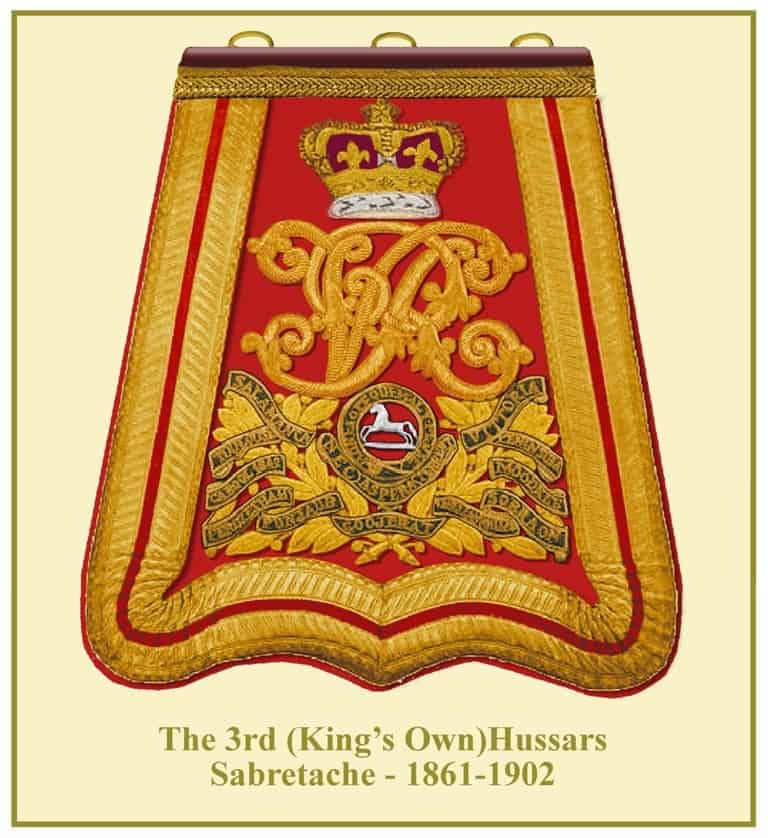
The scarlet faced sabretache was edged in herringbone lace with central scarlet stripe. Beneath the monogram was a leaping horse in silver within the garter under which on a blue scroll, edged gold was the motto “Nec Aspera Terrent”.
Around and below this was a large spray of laurel leaves upon which were eleven battle honours. On the left from the top, SALAMANCA, TALAVERA, CABUL 1842, FEROZESHAH, PUNJAUB. On the right VITTORIA, PENINSULA, MOODKEE, SOBRAON, CHILLIANWALLA and on the bottom, GOOJERAT.
It was carried from 1861 to 1902.
The 4th (Queen’s Own) Hussars
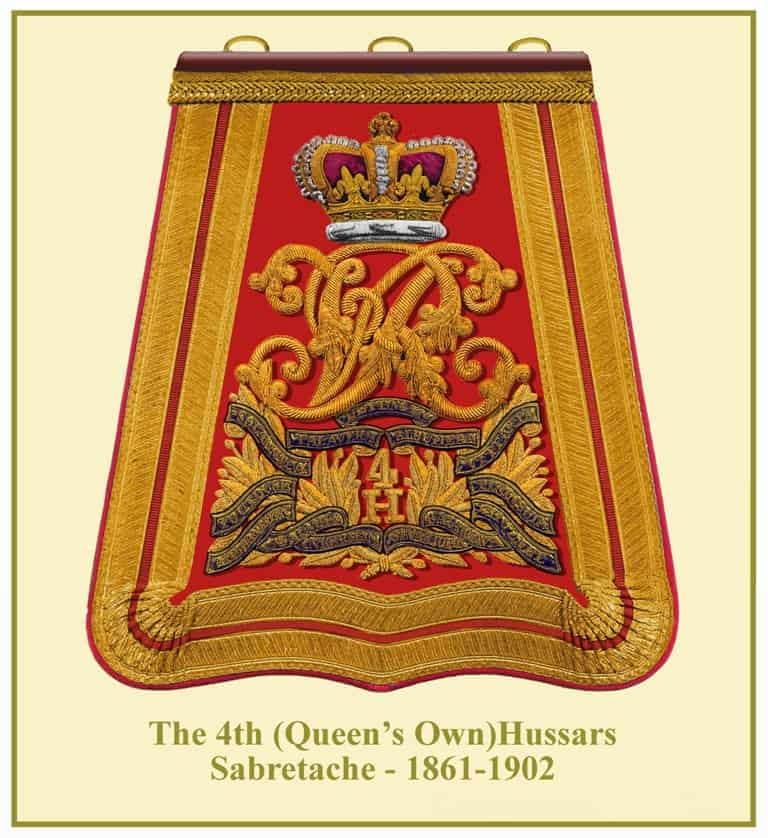
Identical to the 3rd Hussars, except that instead of the horse underneath the monogram was a 4 over H. On the laurel leaves were 13 battle honours – Above the 4 were DETTINGEN, TALAVERA, ALBUHERA.
On the left from the top were SALAMANCA, TOULOUSE, AFGHANISTAN, ALMA & INKERMAN. On the right, VITTORIA, PENINSULA, GHUZNEE, BALACLAVA & SEVASTOPOL.
The 7th Queen’s Own Hussars
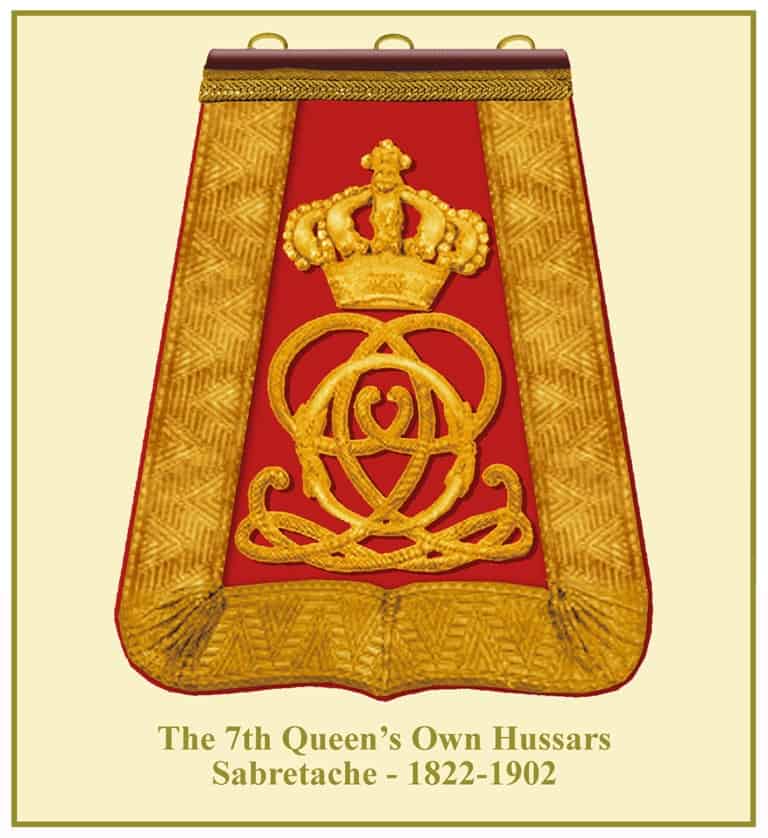
Scarlet faced with the Queen’s Own cypher since at least 1822, this regiment’s sabretache had changed little in design since then.
The 8th (King’s Royal Irish) Hussars

Surrounded on all four sides by “shamrock” pattern lace, the scroll beneath the crown bears the motto “Pristinae Virtutis Memores” in gold on gold background. The monogram is, unusually, in silver surmounted by the Royal Crest beneath which was the Irish Harp with silver strings.
There were four battle honours either side of the harp on a spray of shamrocks. On the left – LESWARREE, ALMA, INKERMAN CENTRAL INDIA. On the right – HINDOOSTAN, BALAKLAVA, SEVASTOPOL, AFGHANISTAN. This was the fourth and last pattern introduced after 1880.
SWORD BELT & SABRETACHE SLINGS
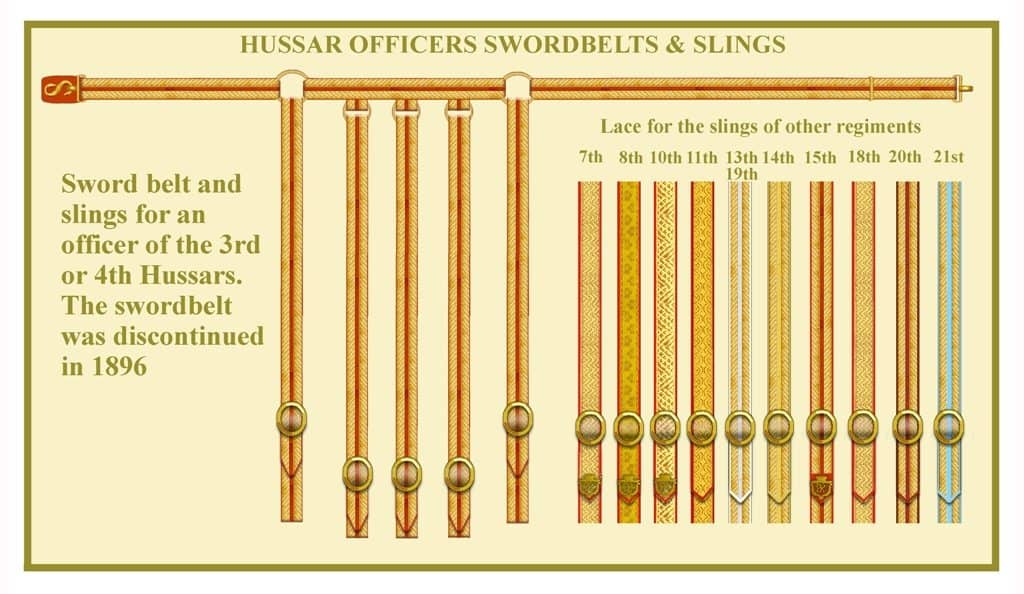
The sword belt worn by hussar officers was mostly not seen as it was underneath the tunic and other jackets. The belt and slings were, according to regulations, 1¼ inches wide and the lace to be the same of that on the sabretache.
For the converted light dragoon regiments and the new ones formed in in 1862, it was of the herringbone pattern lace with coloured central stripe. The lace varied slightly for the 11th Hussars and the 15th Hussars had regular herringbone pattern lace with central stripe. The 7th, 8th, 10th and 15th Hussars had the ends of the belt and sabretache slings decorated with miniature gilt tips as on the pouch belts.
In 1896 the 1822 pattern sword was replaced by the 1856 universal pattern worn by other cavalry. At the same time, the sword belt was also abolished and the new web pattern belt was adopted
SWORDS AND SWORD KNOTS
Hussars and light cavalry had carried the 1822 pattern sword with three bar hilt for 60 years and although the chances of using it had receded by the mid-nineties, it was still carried for full dress and undress occasions. More and more, officers on service had been using the 1856 pattern sword.
In 1896, officers were ordered to wear the 1856 pattern sword and this was followed by all except the 10th Hussars who retained the 1822 pattern until 1914. The sword knot was the gold and crimson type with acorn. The knots of the 13th and 14th Hussars were plain gold.
HUSSAR OFFICERS FULL DRESS SWORD AND LEVEE SWORDS
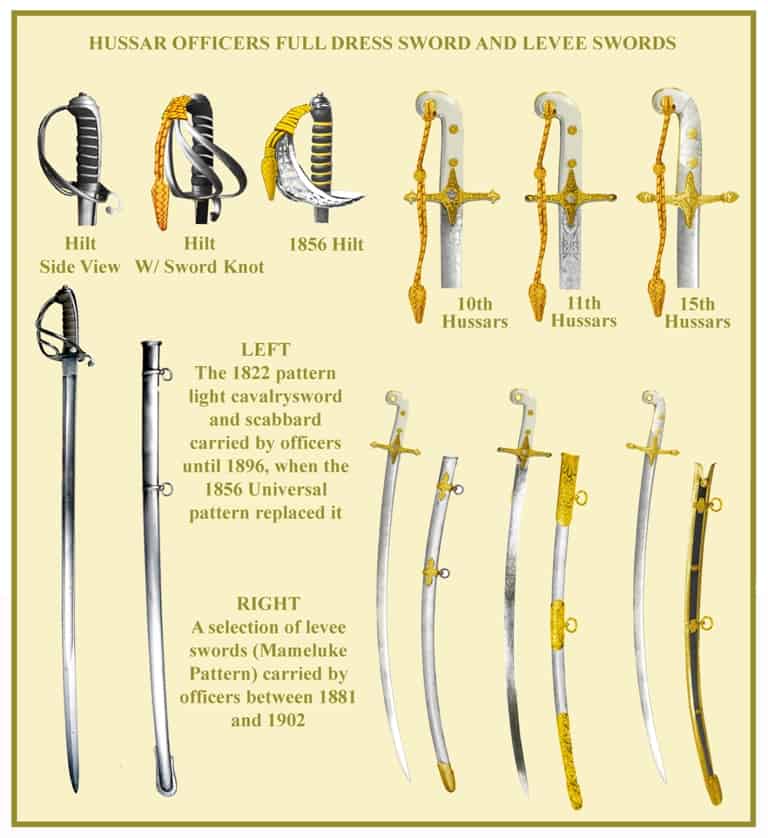
The sword used at levees was of the Mameluke style and in most cases bore regimental devices on the hilt and bar.
The hilt was made of ivory and the embellishments were gilt. Scabbards were highly decorated and despite regulations, were often handed down through generations and as such, varied in style even within a regiment.
The three swords shown from the 10th, 11th and 15th Hussars are excellent examples.
OTHER HUSSAR SABRETACHES
The 10th (Prince of Wales’s Own ) Hussars
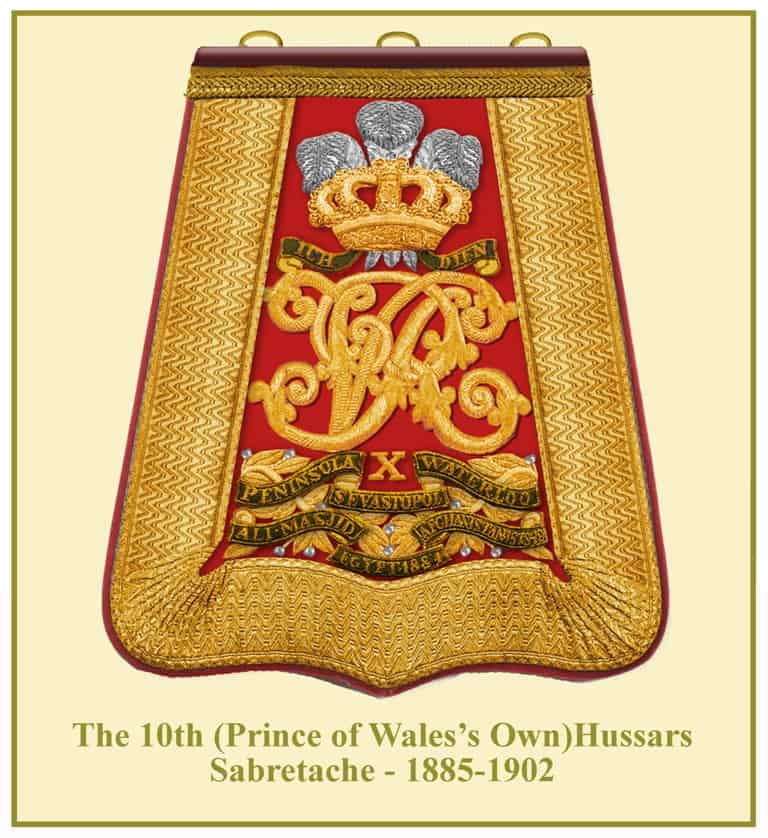
Because of this regiment’s unique pouch belt, they used the same lace surrounding the sabretache as on other appointments including the pill box cap. Above and behind the crown were the Prince of Wales’s feathers with the motto “Ich Dien” on scrolls beneath.
On the gold laurel leaves below were six battle honours in gold on a blue ground. PENINSULA, WATERLOO, SEVASTOPOL, ALI MASJID, AFGHANISTAN 1878-9 & EGYPT 1884. Between the two top honours was the Roman numeral “X”. This was the last pattern worn by the regiment.
The 11th (Prince Albert’s Own ) Hussars
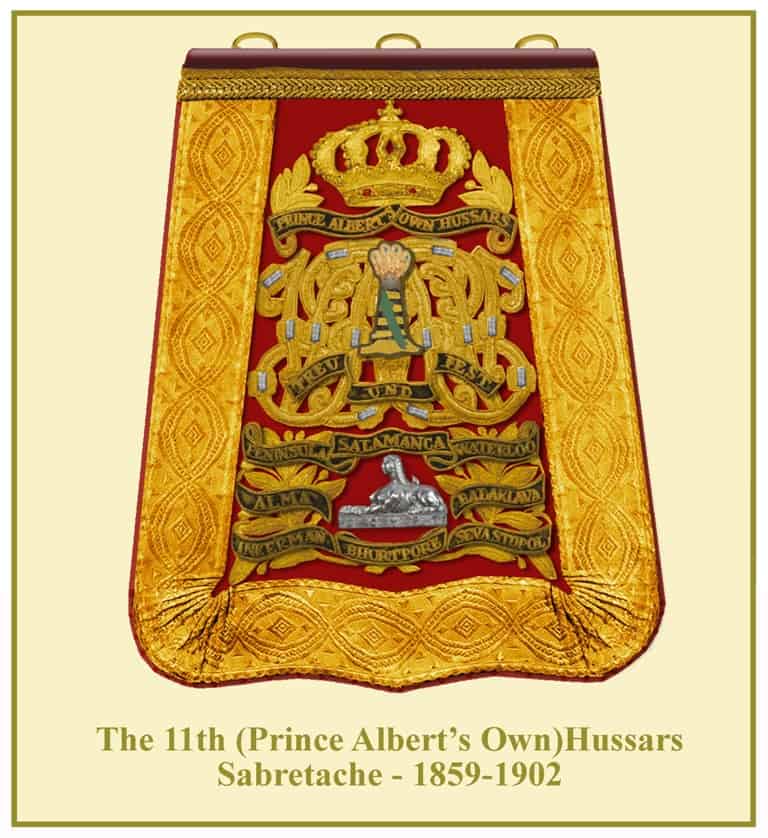
The field of this sabretache was crimson, edged on three sides with the regiments unique diamond and chain lace. Beneath the crown was the regiment’s title on a scroll with laurel leaves above on either side. On the Prince’s gold monogram (studded with silver lozenges) was the emblem on the Arms of Saxony with the motto “Treu und Fest” on scrolls beneath. Beneath the monogram was a silver metal Sphinx with the legend “EGYPT”.
Above the Sphinx was the battle honour SALAMANCA and below BURTPORE. On the laurel leaves on the left were PENINSULA, ALMA, INKERMAN and on the right WATERLOO, BALAKLAVA, SEVASTOPOL. All the honour scrolls were in gold on a field of purple. This was the last pattern worn by the regiment.
The 13th Hussars
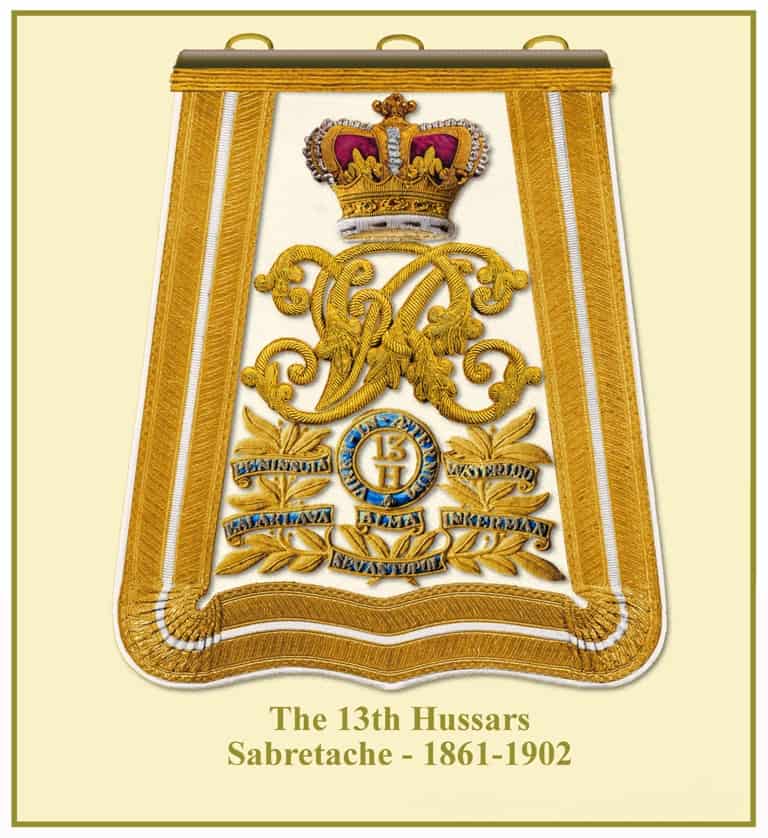
The face was of white cloth (described as “buff”) edged with the gold herringbone (light Dragoon) lace with a white central stripe. Below the VR cypher was a circlet of light blue with the motto “Viret in Aetanem” in gold with gold edging. Within the circlet was “13” over “H” also in gold.
On the laural leaf sprays either side were the honours PENINSULA & BALAKLAVA on the left and WATERLOO & INKERMAN on the right. Below the circlet were ALMA & SEVASTOPOL. All honours were gold on a light blue field.
The 14th (King’s) Hussars
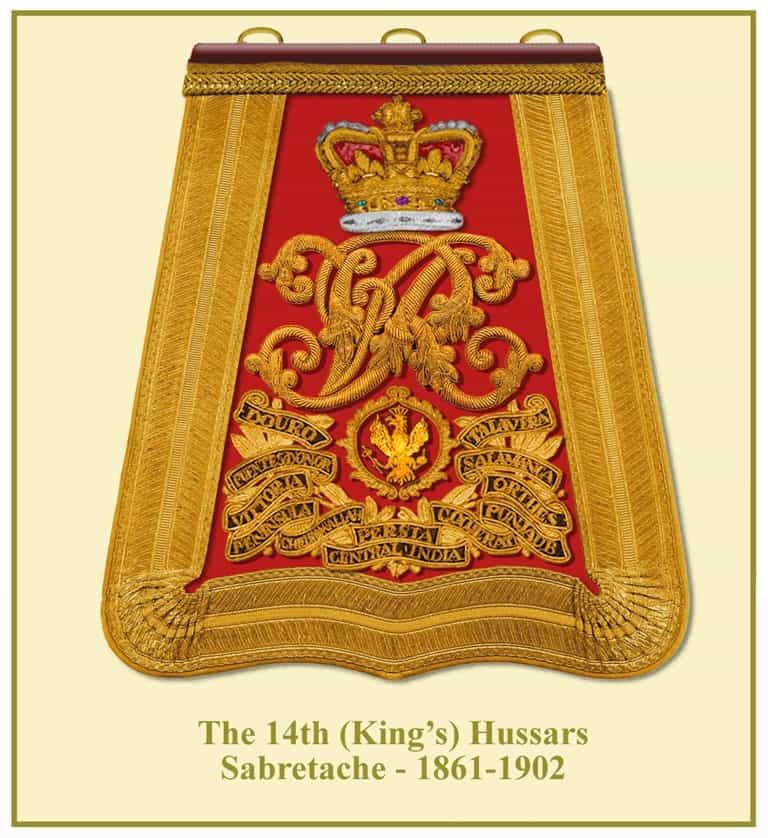
The scarlet faced sabretache was edged with gold herringbone lace with gold central stripe and piping. Beneath the VR cypher was a gold Prussian Eagle badge within a gold laurel wreath.
On laurel leaves surrounding the badge were twelve battle honours. On the left, DOURO, FUENTES D’ONORO, VITTORIA, PENINSULA & CHILLIANWALLAH. On the right TALAVERA, SALAMANCA, ORTHES, PUNJAUB & GOOJERAT. Below the badge were the honours PERSIA & CENTRAL INDIA.
The 15th (The King’s) Hussars
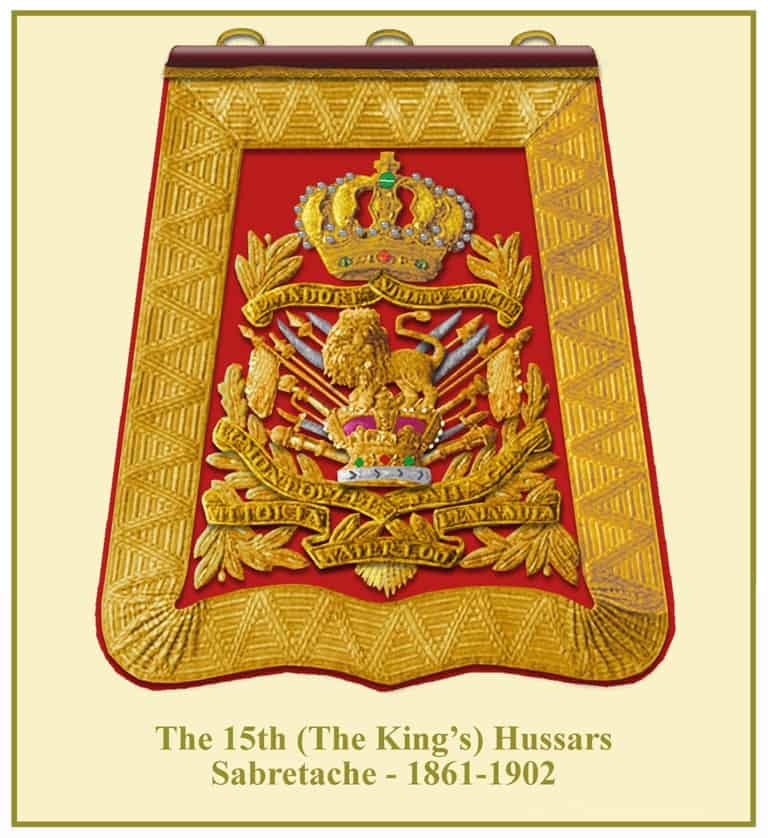
The regiment’s Austrian wave lace edged the scarlet faced sabretache. Beneath the crown were two conjoined scrolls with the battle honours EMSDORF & VILLIERS EN COUCHE in gold on a gold field with laurel sprays above and either side.
Beneath the scrolls was the Royal crest in gold and proper colours. Behind the crest was a trophy of arms in gold with flags either side, the sword blades in silver.
On laurel leaves below were six battle honours. EGMONT OP ZEE & SAHAGUN with VITTORIA & PENINSULA below and at the bottom, WATERLOO. After 1881 the honour AFGHANISTAN was added, but it doesn’t seem to have appeared until late in the century.
This was the last pattern worn in Queen Victoria’s reign. In 1902 a pattern bearing the Edward VII crown appeared and although examples exist, it disappeared within a couple of years.
The 18th Hussars
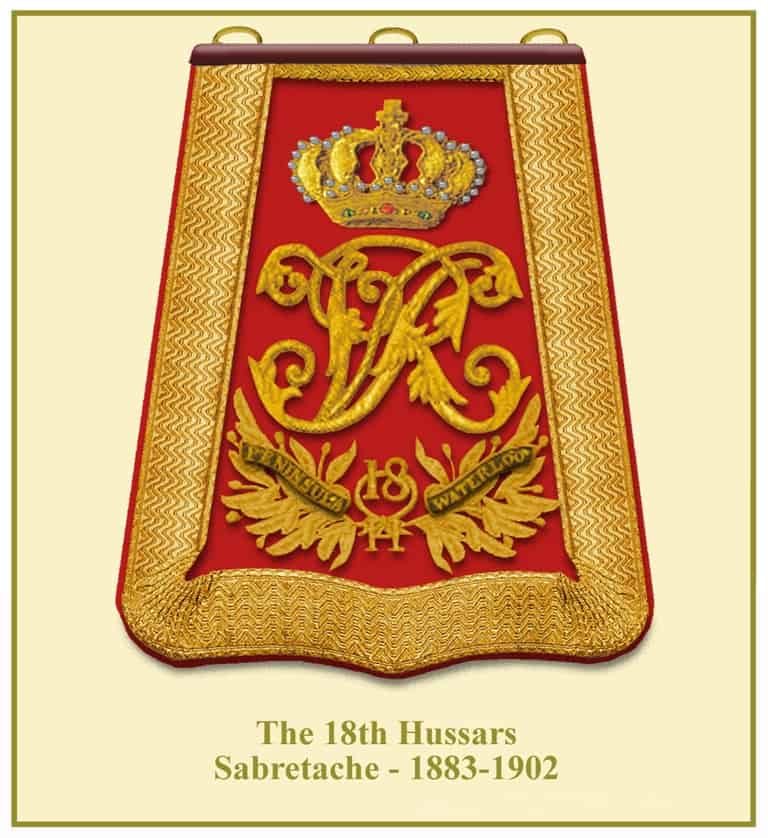
This was the second of only two patterns carried by the regiment. Below the VR cypher were two sprays of laurel leaves connected by a gold loop upon which was the number “18”. On the left was the battle honour PENINSULA and on the left WATERLOO.
The 19th (Princess of Wales’s) Hussars
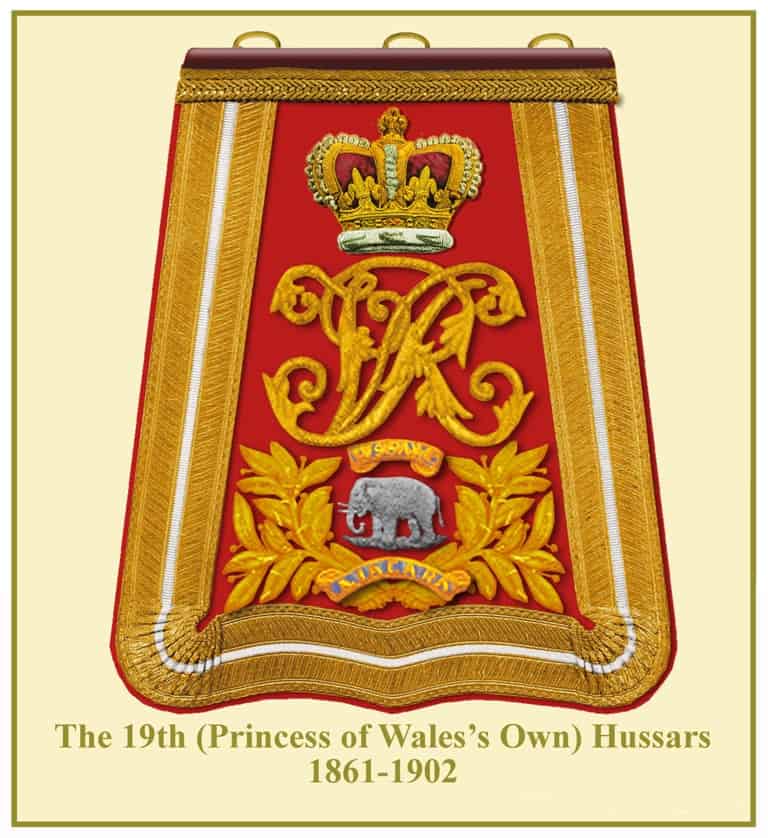
The scarlet faced sabretache was edged in herringbone lace with white central stripe. Beneath the VR cypher was a silver embroidered elephant, surrounded by laurel leaves with the battle honour ASSAYE on a scroll above and NIAGARA below.
The 20th Hussars
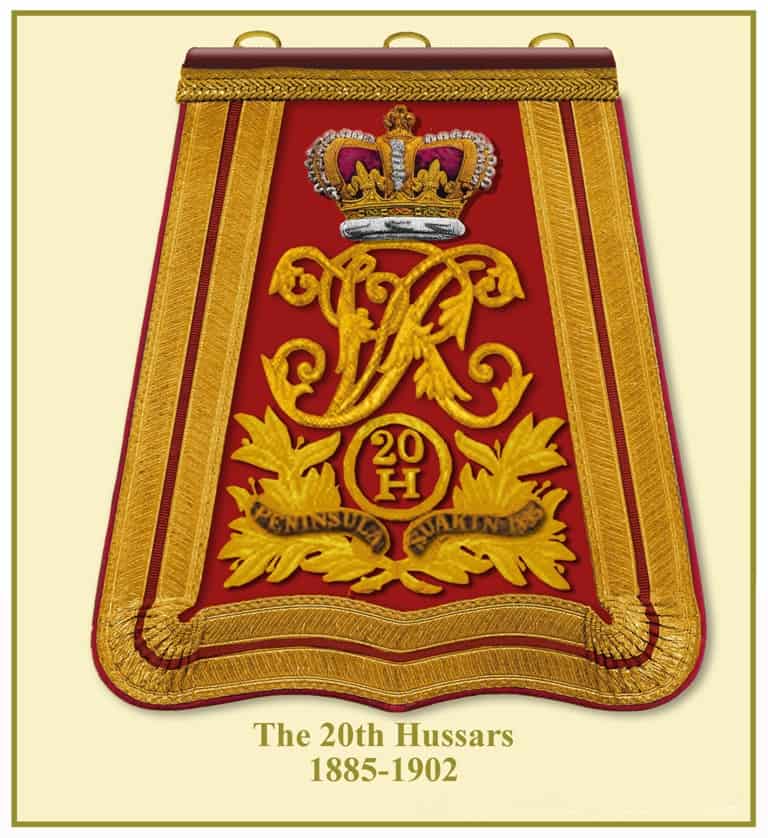
This was the last of two patterns when the battle honour SUAKIN 1885 was added to the previous honour PENINSULA. This was only the second regiment whose face and central stripe on the lace was crimson.
The 21st Hussars
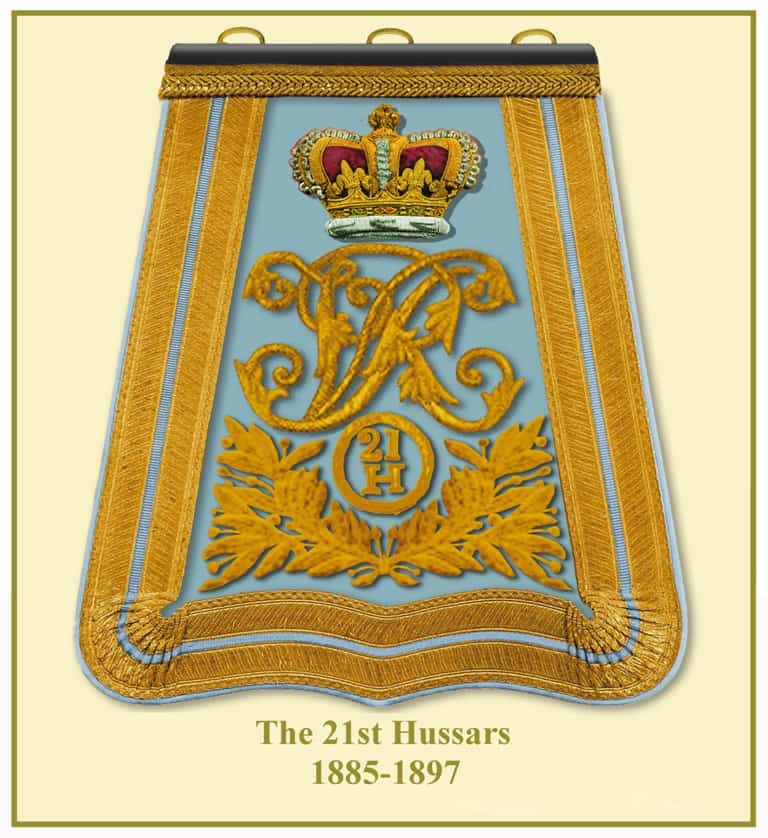
The central stripe on the edging lace was changed from white to French grey in 1884. However, sabretaches with the white stripe were still being worn when the regiment was converted to Lancers in 1897.


